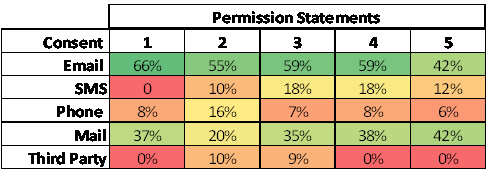 Without third-party data much of today’s direct communication with customers and prospects could not take place. PR and marketing has progressed over the decades from supporting roles in product-centred advertising sales; to customer-centred targeting; to collecting third-party data to identify and market to potential new customers; to generating more interactive and personal contact in emails and on social networks.
Without third-party data much of today’s direct communication with customers and prospects could not take place. PR and marketing has progressed over the decades from supporting roles in product-centred advertising sales; to customer-centred targeting; to collecting third-party data to identify and market to potential new customers; to generating more interactive and personal contact in emails and on social networks.
Hardly surprising then that consumers are more marketing savvy and cynical about exploitation and profit-driven use of their personal information and so increasingly less-likely to opt-in to agree to contact from brands and especially to third party access to their data.
The abused privilege of almost limitless consent to market is disappearing.
Most marketers know this. Around two-thirds (68%) expect changes in EU legislation to fundamentally or importantly affect their organisation (Source fast.MAP Data Elephant Events 2015), but very few are tackling it. For those pragmatic leaders who are, the first task is to measure consent levels.
Organisations are driven by targets – for sales, products, channels and cost. Data is the enabler.
Marketing consent used to be an annoying legal chore that bluntly excluded 5% of the file, but brands can no longer afford to play “hide the opt-out statement”. Consent is not passive and is now the underlying process upon which databases are built. Large numbers of consumers are included or excluded because of it. The expected 5% drop of 15 years ago, is now closer to 50% for many brands.
Words really do matter when it comes to creating permission (opt-in) statements – it’s a job for creatives, not lawyers – and different age groups/ sexes are motivated differently.
Different statements need to be crafted to increase the percentage of opt-ins from different target groups. So if you’re targeting say, a young female audience via facebook you need to use a different statement than, say, for an older, mixed-sex age group via direct mail.
The fast.MAP/Opt-4 Data Permission Benchmark allows brands to measure the success of their wording; identify areas of strength and weakness; view statements that are strong where theirs is weak; re-write to correct this and benchmark again.
ICO Guidance encourages brands to give choice over the channels through which consumers receive marketing. Our research shows choice of wording, structure, channel and order dramatically affects consent rates. So important choices need to be made.
Is the inclusion of third-party data consent crucial? If not, don’t ask for it since it suppresses consent levels across all channels? How important is telephone consent? What about the new media which will grow in importance?
As an example, here are the consent levels achieved by five slightly different permission statements.

Which statement is the best?
The decision about which statement is selected will have profound implications on the amount of data generated and the ability of the organisational managers to hit their targets.
Selecting statement 5 over statement 2 would more than double the volume of direct mail contact available, but comes at the price of the complete removal of third party data, halving the amount of telephone data and attracting fewer email consents.
These choices have an effect on an organisation’s revenues, costs and politics. Consent is power.
Methodology
Regarding each data permission statement benchmarked, each statement goes through fast.MAP’s Data Permission Benchmark (partnered by OPT-4), which involves 500 consumers from fast.MAP’s consumer panel being asked if they would consent – and why. The information in the article is based on what has been learned from the results of benchmarking hundreds of separate statements.
Article written by David Cole, MD of fast.MAP
PRmoment Leaders
PRmoment Leaders is our new subscription-based learning programme and community, built by PRmoment specifically for the next generation of PR and communications leaders to learn, network, and lead.
PRmoment LeadersIf you enjoyed this article, sign up for free to our twice weekly editorial alert.
We have six email alerts in total - covering ESG, internal comms, PR jobs and events. Enter your email address below to find out more:







